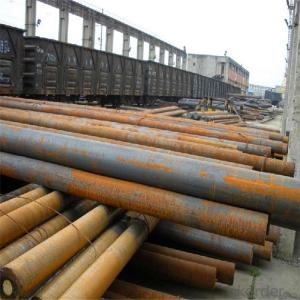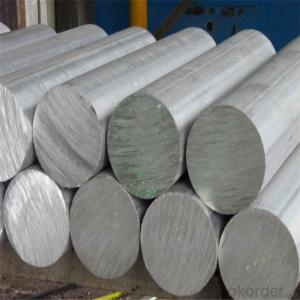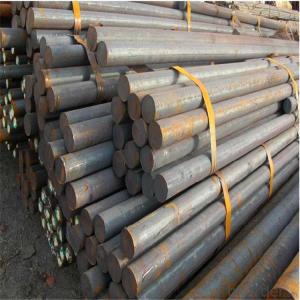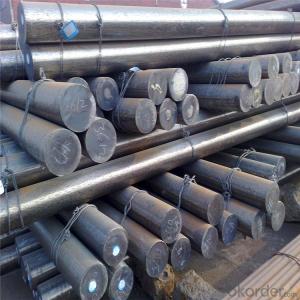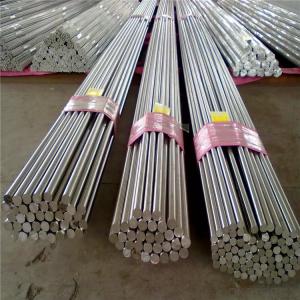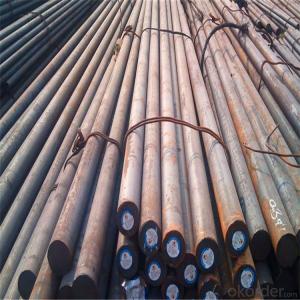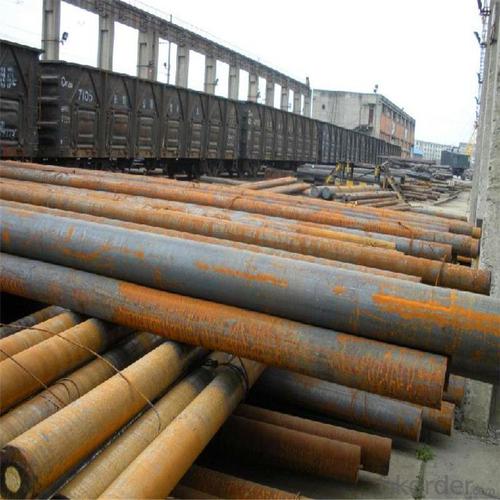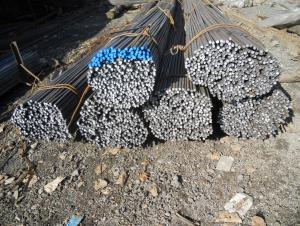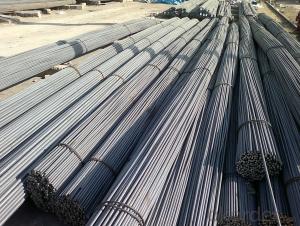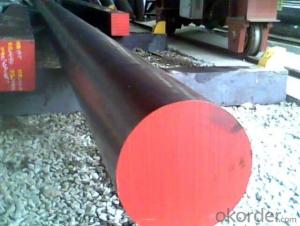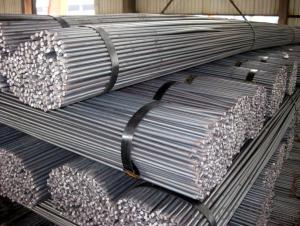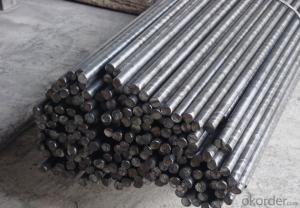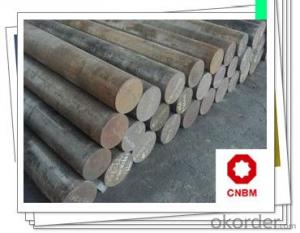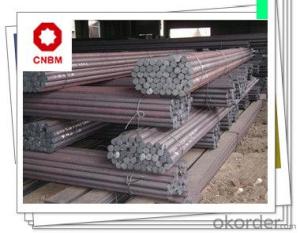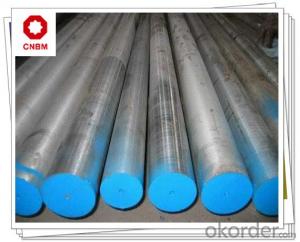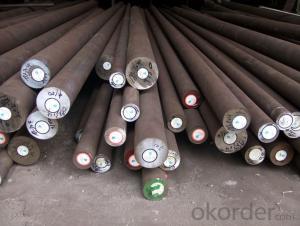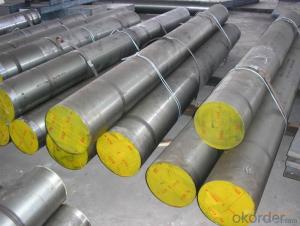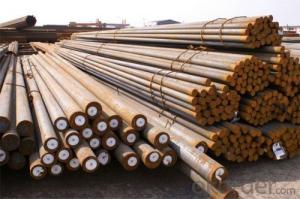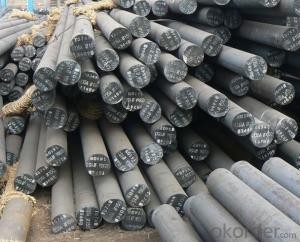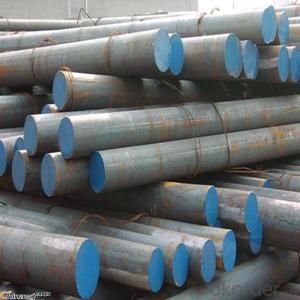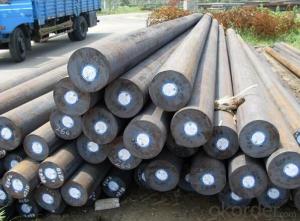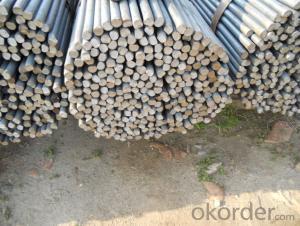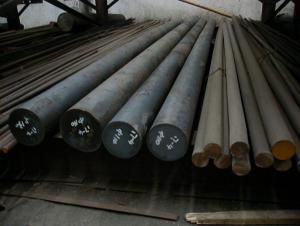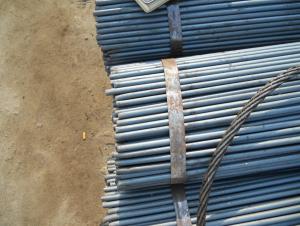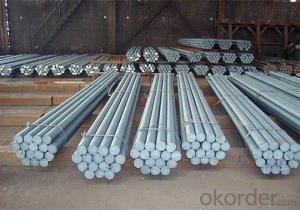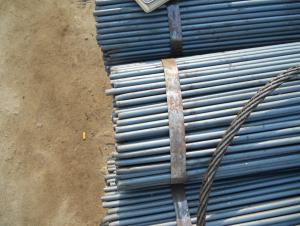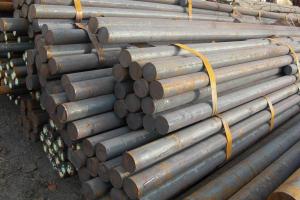S355J2 Steel Round Bar Alloy Steel Round Bar 4140
- Loading Port:
- Tianjin
- Payment Terms:
- TT OR LC
- Min Order Qty:
- 100 m.t.
- Supply Capability:
- 500000 m.t./month
OKorder Service Pledge
OKorder Financial Service
You Might Also Like
Specification
S355J2 Steel Round Bar Alloy Steel Round Bar 4140
Product Description of S355J2 Steel Round Bar Alloy Steel Round Bar 4140
1. Steel grade: ASTM4140, SCM440, 42CrMo, DIN1.7225
2. Length: 6M-12M
3. Diameter: 16mm-300mm
4. Product range: round bar, flat bar, square bar
5. Technique: Hot rolled, forged, cold drawn
Specification of S355J2 Steel Round Bar Alloy Steel Round Bar 4140
Material | SCM4140 | Round bar | Dia(mm) | 16-300mm |
Process | EAF + LF + VD + Forged + Heat Treatment (optional) | Length (mm) | Max 12m | |
Heat treatment | Normalized / Annealed / Quenched / tempered | Flat bar | Thickness(mm) | 8-500mm |
Delivery condition | Hot forged +Rough machined (black surface after Q/T)+ Turned (optional) | Width(mm) | 70-200mm | |
Test | Ultrasonic test according to SEP 1921-84 D/d | Length (mm) | Max 12m |
Chemical Composition of S355J2 Steel Round Bar Alloy Steel Round Bar 4140
C | Si | Mn | Cr | Mo | P | S |
0.38~0.43 | 0.15~0.35 | 0.75~1.00 | 0.8~1.1 | 0.15~0.25 | ≤0.035 | <0.04< td=""> |
Photo Show of S355J2 Steel Round Bar Alloy Steel Round Bar 4140
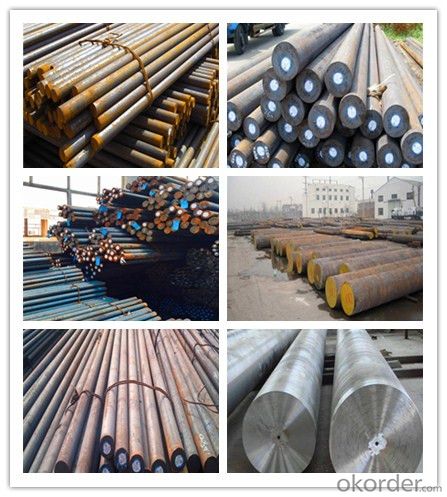
Packing and Delivery:
Packing in bundle package, or as customer's requirements.
Delivery Detail: 45 days after receiving the deposit.
Usage and Applications of S355J2 Steel Round Bar Alloy Steel Round Bar 4140
1. Steel round bar is used in a large number of architectural and engineering structures. Or it can be used in construction of plants for the production of steel house frames, high-voltage transmission towers, bridges, vehicles, boilers, containers, ships, etc.
2. And we can use this kind of product on the performance of the mechanical parts if the demand is not very high.
3. Some special material steel round bar can be used for main shaft of steamer, hummer shank, with big section and supper force.
Company Information
CNBM International Corporation is the most important trading platform of CNBM group.
Whith its advantages, CNBM International are mainly concentrate on Cement, Glass, Iron and Steel, Ceramics industries and devotes herself for supplying high qulity series of refractories as well as technical consultancies and logistics solutions.

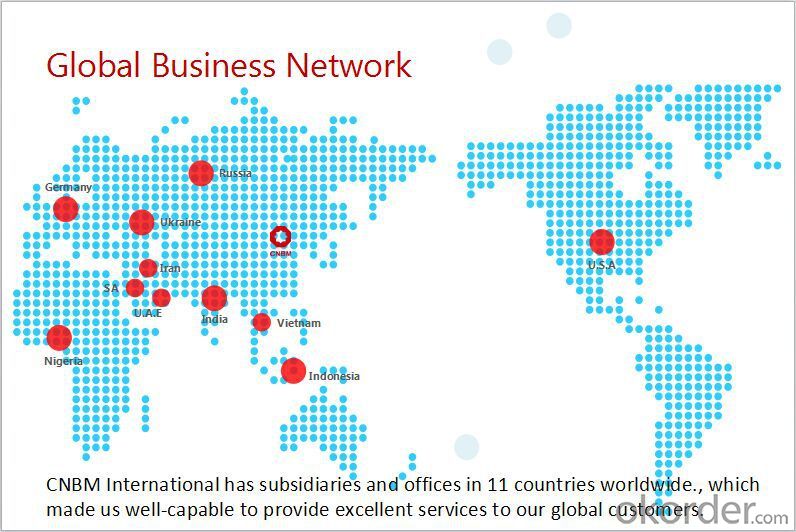
F A Q
1, Your advantages?
professional products inquiry, products knowledge train (for agents), smooth goods delivery, excellent customer solution proposale
2, Test & Certificate?
SGS test is available, customer inspection before shipping is welcome, third party inspection is no problem
3, Factory or Trading Company?
CNBM is a trading company but we have so many protocol factories and CNBM works as a trading department of these factories. Also CNBM is the holding company of many factories.
4, Payment Terms?
30% TT as deposit and 70% before delivery.
Irrevocable L/C at sight.
5, Trading Terms?
EXW, FOB, CIF, FFR, CNF
6, After-sale Service?
CNBM provides the services and support you need for every step of our cooperation. We're the business partner you can trust.
For any problem, please kindly contact us at any your convenient time.
We'll reply you in our first priority within 24 hours.
- Q: What are the different grades of carbon steel round bars for structural applications?
- The different grades of carbon steel round bars commonly used for structural applications include ASTM A36, ASTM A572, and ASTM A992.
- Q: Can steel round bars be used for making wire?
- Yes, steel round bars can be used for making wire by undergoing a process called wire drawing. In this process, the steel round bar is pulled through a series of progressively smaller dies, reducing its diameter and elongating it into wire form.
- Q: What are the different grades of stainless steel round bars?
- Stainless steel round bars are available in various grades, each offering unique properties and characteristics. The most common grades of stainless steel round bars include: 1. Grade 304: This is the most widely used grade of stainless steel round bars. It offers good corrosion resistance, high durability, and excellent formability. Grade 304 is suitable for a wide range of applications, including food processing equipment, kitchen appliances, and architectural components. 2. Grade 316: Known for its superior corrosion resistance, grade 316 stainless steel round bars are often used in marine environments or industries where exposure to corrosive substances is common. It also offers excellent resistance to high temperatures, making it suitable for heat exchangers and chemical processing equipment. 3. Grade 410: This stainless steel grade is known for its high strength and hardness. Grade 410 round bars are often used in applications where resistance to corrosion and moderate heat is required, such as cutlery, pump shafts, and valve parts. 4. Grade 420: With increased carbon content, grade 420 stainless steel round bars offer higher strength and hardness compared to grade 410. It is commonly used in the production of surgical instruments, dental tools, and blades. 5. Grade 430: This grade of stainless steel round bars is known for its good corrosion resistance and formability. It is often used in applications involving decorative trim, automotive components, and kitchen appliances. These are just a few examples of the different grades of stainless steel round bars. It is important to choose the appropriate grade based on the specific requirements of your application to ensure optimal performance and longevity.
- Q: Can steel round bars be machined or forged?
- Yes, steel round bars can be both machined and forged. Machining involves removing material from the round bar to create a desired shape or size, while forging involves shaping the steel through the application of heat and pressure. Both processes are commonly used to manipulate steel round bars for various applications.
- Q: Can steel round bars be used for making propeller shafts?
- Yes, steel round bars can be used for making propeller shafts. Steel is a common material choice for propeller shafts due to its strength, durability, and resistance to corrosion. The round shape of the steel bar allows for efficient transfer of rotational energy, making it suitable for propeller shafts in various applications.
- Q: Can steel round bars be used for making tools or machinery parts?
- Yes, steel round bars can be used for making tools or machinery parts. Steel round bars are commonly used in the manufacturing industry due to their high strength, durability, and ability to withstand heavy loads. They can be machined, forged, or welded into various shapes and sizes to create different tools and machinery parts.
- Q: How do steel round bars compare to copper round bars?
- Steel round bars and copper round bars have distinct properties that make them suitable for different applications. Firstly, steel round bars are known for their exceptional strength and durability. Steel is a versatile and widely-used material that can withstand high levels of stress, making it ideal for structural and industrial applications. It has a high tensile strength, which means it can resist pulling forces without breaking. Steel round bars are commonly used in construction projects, automotive components, and machinery manufacturing. On the other hand, copper round bars possess unique characteristics that differentiate them from steel. Copper is an excellent conductor of heat and electricity, making it indispensable in electrical wiring and plumbing systems. It is also highly resistant to corrosion, which is why copper pipes are widely used in plumbing applications. Additionally, copper has antimicrobial properties, which makes it a preferred material for medical equipment and food processing industries. When it comes to cost, steel round bars are generally more affordable than copper round bars. Steel is abundantly available and its production cost is lower compared to copper. This cost advantage makes steel a popular choice for many budget-conscious applications. In terms of appearance, steel round bars have a sleek and metallic finish, while copper round bars have a distinct reddish-brown appearance. This visual difference often influences the choice between the two materials in architectural and decorative applications. In summary, steel round bars and copper round bars have different properties that make them suited for specific purposes. Steel offers exceptional strength and durability, making it suitable for structural and industrial applications, while copper is valued for its conductivity, corrosion resistance, and antimicrobial properties, making it ideal for electrical, plumbing, and medical applications. The choice between steel and copper depends on the specific requirements of the project and the desired properties of the material.
- Q: What are the different types of steel round bar alloys for improved toughness and wear resistance?
- There are several different types of steel round bar alloys that are specifically designed to offer improved toughness and wear resistance. These alloys are often used in applications where strength and durability are essential. Some of the commonly used alloys include: 1. Alloy Steel: Alloy steel round bars are made by adding different alloying elements such as chromium, nickel, molybdenum, or vanadium to enhance their mechanical properties. These alloys offer increased strength, toughness, and wear resistance. 2. Stainless Steel: Stainless steel round bars are corrosion-resistant alloys that contain a minimum of 10.5% chromium. They have excellent toughness, high strength, and superior wear resistance. Stainless steel round bars are widely used in industries such as aerospace, automotive, and construction. 3. Tool Steel: Tool steel round bars are specifically designed for applications where high wear resistance and toughness are crucial. These alloys are commonly used in the manufacturing of cutting tools, dies, and molds. Tool steel alloys often contain elements such as tungsten, vanadium, or molybdenum to improve their hardness and wear resistance. 4. Carbon Steel: Carbon steel round bars are widely used due to their high strength and toughness. These alloys contain varying amounts of carbon and are known for their excellent wear resistance. Carbon steel round bars find applications in industries such as manufacturing, construction, and automotive. 5. Bearing Steel: Bearing steel round bars are designed to withstand high stress and provide excellent wear resistance. These alloys are commonly used in the production of ball bearings, roller bearings, and other high-performance bearing components. Bearing steel alloys typically contain elements such as chromium, silicon, and manganese to enhance their mechanical properties. In conclusion, there are various types of steel round bar alloys available that offer improved toughness and wear resistance. The selection of the most suitable alloy depends on the specific application requirements and desired mechanical properties.
- Q: How do you prevent warping during welding of steel round bars?
- To prevent warping during welding of steel round bars, there are several precautions that can be taken: 1. Proper fit-up: Ensure that the round bars are properly aligned and fit together before welding. Any gaps or misalignments can lead to uneven heating and cooling, increasing the chances of warping. 2. Welding sequence: Divide the welding into multiple smaller sections or segments instead of welding continuously along the entire length of the round bar. This will help distribute the heat more evenly and reduce the risk of warping. 3. Welding technique: Use a welding technique that minimizes heat input, such as pulse welding or tack welding. These techniques allow for controlled and intermittent heating, which reduces the chances of warping. 4. Preheating: Preheating the round bars before welding can also help prevent warping. This is especially important for thicker bars or when welding dissimilar metals. Preheating helps to reduce the temperature gradient between the weld and the surrounding material, minimizing the risk of warping. 5. Heat control: Monitor and control the heat input during welding. Excessive heat can cause rapid expansion and contraction, leading to warping. Use appropriate welding parameters, such as lower amperage and shorter welding times, to control the heat input. 6. Welding fixtures: Use welding fixtures or jigs to hold the round bars in place during welding. This helps to maintain proper alignment and prevents movement during the welding process, reducing the chances of warping. 7. Post-welding cooling: Allow the welded round bars to cool down slowly and naturally. Avoid rapid cooling methods like quenching, as they can induce stress and increase the risk of warping. By implementing these measures, the risk of warping during welding of steel round bars can be significantly reduced, resulting in better quality and more reliable welded joints.
- Q: How are steel round bars used in the construction of transmission towers?
- Steel round bars are used in the construction of transmission towers as a primary structural component. They provide strength and stability to the tower, supporting the weight of the transmission lines and withstanding the forces of wind and other environmental factors. The round bars are typically used in the fabrication of the tower's vertical members, such as the main columns and bracing, ensuring the tower's durability and ability to transmit electrical power efficiently.
Send your message to us
S355J2 Steel Round Bar Alloy Steel Round Bar 4140
- Loading Port:
- Tianjin
- Payment Terms:
- TT OR LC
- Min Order Qty:
- 100 m.t.
- Supply Capability:
- 500000 m.t./month
OKorder Service Pledge
OKorder Financial Service
Similar products
Hot products
Hot Searches
Related keywords
